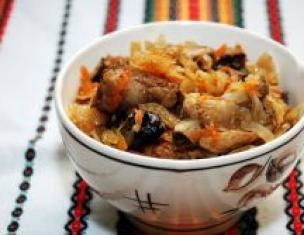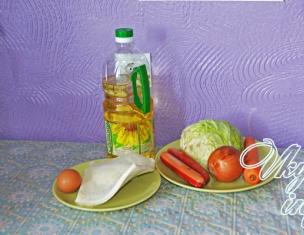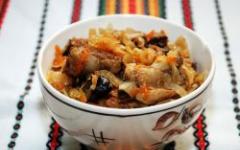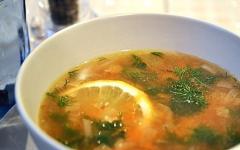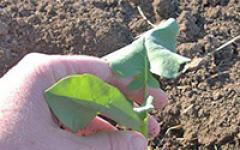Spinach is one of the favorite vegetable crops of the French, Italians, Americans and other nations.
In addition to proteins, fats, mono- and disaccharides, starch, fiber, organic acids, spinach leaves contain flavonoids and a very good nature-balanced multivitamin complex, which contains provitamin A (carotenoids), vitamins of group B, C, P, PP, E, N. These vitamins in spinach leaves are accompanied by almost all essential macro and micronutrients.
Spinach contains vitamin D2, which is so necessary for children to rickets prevention. This is probably why in many countries spinach puree is an indispensable component of the menu for newborns.
In addition, spinach is rich in iodine and iron, making it a valuable product when anemia.
Spinach is especially useful in early spring for the prevention of beriberi and the restoration of the immune system.
Spinach is good for people of any age. It is used as diet productwith diseases of the nervous system, exhaustion, anemia, anemia, hypertension, diabetes, gastritis, enterocolitis.
Spinach has a light tonic, laxative, diuretic and anti-inflammatory action. Spinach leaves are useful for recovering from serious illnesses.
Spinach also improves the pancreas, stimulates the intestines, providing mild laxative effect.
Spinach is good for people who suffer. disturbance of the nervous system and overwork, as it acts as a mild natural sedative, it promotes healthy sleep and relaxation. Spinach is useful hypertensives. In addition, it favorably affects the eyes, preventing retinal detachment.
Spinach dishes should be used immediately., because when stored for 24-48 hours, nitrate salts, which are harmful for the body, are formed from the nitrate salts in spinach.
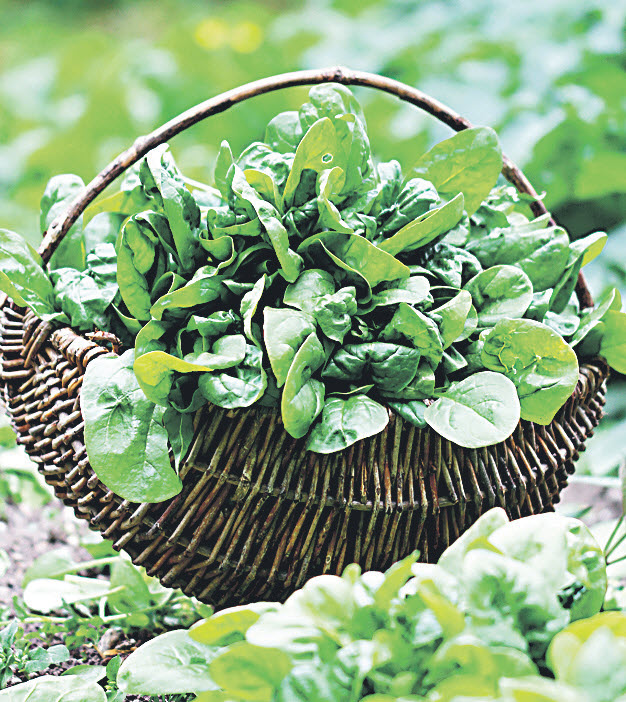 Sorrel, in its nutritional properties is not inferior to spinach. Plant possesses antiscorbutic, diuretic and tonic effect. Often, for the preparation of the first course, sorrel is mixed with spinach, nettle and other cultural and wild vegetables.
Sorrel, in its nutritional properties is not inferior to spinach. Plant possesses antiscorbutic, diuretic and tonic effect. Often, for the preparation of the first course, sorrel is mixed with spinach, nettle and other cultural and wild vegetables.
Despite the healing properties of sorrel, his not recommended for use in large quantities and for a long time. Due to the high content of oxalic acid, excessive consumption of sorrel can cause a violation of mineral metabolism in the body, the development of kidney stones and gout. Sorrel is contraindicated in pregnancy.
Tannins, vitamins C, K and calcium contained in sorrel, have a therapeutic effect at loosened and bleeding gums. Therefore, the infusion prepared from the leaves of sorrel, has long been used for rinsing the mouth. Strengthens the gums and helps powder prepared from the roots of sorrel.
Sorrel activates the liver and bile formationimproves activity intestines, is an blood purifying and painkiller. A decoction of sorrel leaves is used as an antidote for some poisoning. Sorrel helps with colitis, enterocolitis, diseases of the digestive tract, hemorrhoids, anal fissures.
Like spinach, sorrel is an excellent tool for hypovitaminosis (especially vitamin C). As a tonic, it is useful to use it in the form of a decoction with loss of strength and general weakness.
In addition, sorrel - one of the best tools used in climax, both female and male.
Spinach and Sorrel Recipes
Potato soup with leaves of young spinach
Based on 3 servings you will need: 400-500 g of potatoes, 200 g of spinach, 1.5 cups of cream or milk, 1 tbsp. spoon of butter, chopped dill, parsley, 5 cups boiling water.
Peel and finely chop the potatoes, boil them in salted boiling water, lower the spinach, let it boil. Add cream or milk, butter, boil.
Before serving, sprinkle the soup with chopped dill and parsley.
 Spinach puree soup
Spinach puree soup
Based on 2 servings you will need: 1 package of frozen spinach, 200 g of cream, 50 g of Parmesan cheese, 4-5 slices of white loaf, 2-3 cloves of garlic, salt, black pepper powder to taste.
Spinach, without defrosting, break into pieces and put in a saucepan. Pour a glass of boiling water and put on the fire. Cook after boiling for 5 minutes.
While spinach is cooking, make garlic croutons. Fry chopped garlic in a small amount of vegetable oil for 2-3 minutes. Cut into cubes loaf and put in a pan of garlic butter. Fry croutons until browning. Then remove the saucepan from the spinach from the heat, cool slightly and use the blender to beat the contents into the mashed potatoes. Add the cream, salt, pepper to taste, pour back into the pan and return the soup to the fire. Bring to a boil and hold on the fire for another 1-2 minutes.
Pour the soup in plates, sprinkle with grated cheese and add croutons.
Rice soup with spinach and lemon
Based on 3 servings you will need: ½ cup of rice, 350 g of spinach leaves, 1 tbsp. spoon butter, ¼ cup sour cream, 6 glasses of water, ½ lemon, parsley, dill.
Boil rice in salted boiling water, put spinach in it, bring the soup to readiness. Season the soup with butter, sour cream and boil.
Before serving, sprinkle the soup with chopped parsley, dill. Separately file the lemon slices, peeled.
Carrot and Spinach Cream Soup
Based on 3 servings you will need: 300 g of carrots, 200 g of spinach, 1 tbsp. spoon of butter, 6 teaspoons of flour, 6 glasses of water, parsley, dill.
Finely chop carrots, boil, strain and wipe. Boil spinach leaves in salted boiling water, combine with mashed carrots and broth. Add flour, toasted with butter, boil.
Before serving, sprinkle with chopped parsley and dill soup.
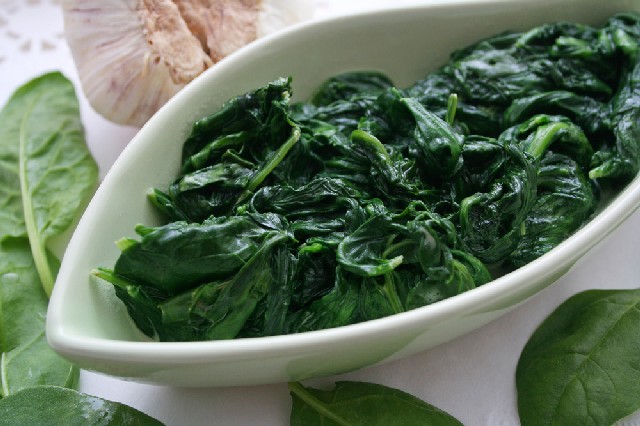 Spinach stewed in butter
Spinach stewed in butter
Would need: 500 g of spinach, 2 tbsp. spoons of butter.
Washed spinach leaves put in a heated pan with oil, salt to taste and simmer under the lid closed until tender.
Add spinach to butter.
Braised spinach can be mixed with finely chopped and roasted onions and a handful of crushed walnuts. But it will be a new version of the dish.
Cream of chicken soup with sorrel
Based on 4 servings you will need: 2 chicken breasts with skin, large bunch of sorrel, 3-4 potatoes, 1 onion, 1/2 of sweet pepper, 200 ml of cream of 9% fat content, salt to taste.
Put the breasts in the pan, pour 1.5 l cold water. Put the pan on a high heat and bring to a boil, remove the foam. Reduce heat to medium, cook for 20 minutes. Breast shift on a plate. Broth strain.
Potatoes and onions to clear, coarsely chop. Sweet pepper wash, chop.
Filtered broth bring to a boil, put potatoes, onions and bell pepper. Boil 10 minutes.
Cut chicken breasts into small pieces. Sorrel wash and dry. Add chicken and sorrel to the soup, cook for 3 minutes. Pour the soup into a blender and grind into mashed potatoes.
Rub the mash through a sieve. Pour it into a clean pan, add cream. Stir, salt to taste and warm up, not boiling.
Sorrel or spinach stewed in oil
This dish, which can be prepared from sorrel or spinach (or both, together) will serve as a good vitamin and dietary side dish for any meat, poultry or fish dish.
Would need: 1.5 kg of sorrel (spinach), 4 tbsp. spoons butter, 1 cup chopped onions, 3 tbsp. tablespoons chopped parsley, 1/2 cup sour cream, 1/3 cup bread crumbs, 1/3 cup grated cheese, salt and garlic to taste.
Melt the butter in a pan, fry the onion in it for 10 minutes. Then add sorrel and fry, stirring continuously, for 3 minutes. After that add chopped garlic, parsley, sour cream, crackers and cheese. Heat the mixture, not boiling it, then salt it.
Salmon with sorrel sauce
Based on 3 servings, you will need: 3 steaks of salmon 200 g each, ½ cup peeled walnuts, 1-2 sprig of tarragon, 1-2 sprigs of fresh chopped basil, 1 tbsp. spoon of butter.
For the marinade:1 celery stalk, 1 sprig of rosemary, 2 tbsp. spoons of vegetable oil.
For the sauce: 1 bundle of sorrel, 2 tbsp. spoons of dry white wine, 1 small onion, 1 cup of cream of 22% fat, 1.5 tsp of lemon juice, salt, white ground pepper to taste.
Celery wash, cut into thin ribbons. Rosemary disassembled into leaves. Put steaks in a bowl, pour over oil, add celery and rosemary leaves. To cover cling film and leave in a warm place for 20 minutes.
Prepare the sauce. Sorrel wash, dry. Peel and chop the onion. Put sorrel and onions in a saucepan, pour in wine and put on medium heat for 2 minutes. Add cream and lemon juice, mix and bring to a boil. Cook over medium heat for 12 minutes. Pour the sauce into a sieve and rub. Return the sauce to the skillet, add salt and white pepper to taste, mix. Cover and leave in a warm place.
Grind nuts with tarragon and basil in a blender, put in a bowl, mix with butter.
Dry salmon steaks with napkins, place in a baking dish, salt and pepper. On top of each piece put a nut paste. Place in preheated to 180 degrees oven for 20 minutes.
Serve with sorrel sauce.
Sorrel, Spinach and Celery Salad
Based on 4 servings, you will need: 100 g of sorrel and spinach, 200 g of green lettuce, 2 stalks of stalked celery.
All components are crushed, salt, pepper to taste and season with vegetable oil or mayonnaise.
Omelet with mashed spinach and sorrel
For puree you will need: 350 g of spinach, 100 g of sorrel, 3 tsp of flour, 2 tbsp. spoons of butter, ½ cup of milk, 1 egg, ½ tbsp. spoons of sugar.
For omelet: 3 eggs, 6 tbsp. spoons of milk, butter.
Cook spinach and sorrel in salted boiling water, drain in a colander, wipe. Fry flour with ½ tbsp. with a spoonful of butter, boil with a glass of broth of spinach and sorrel, combine with pureed vegetables. Add boiled milk, diluted with ¼ Art. spoons of butter, yolk, sugar and salt to taste. Warm up without boiling.
Beat 3 eggs with 6 tbsp. spoons of milk, salt to taste, mix, divide the mixture in half and cook two omelets. One omelet to put in a deep refractory dish, cover it with cooked mashed potatoes and cover with the second omelette. Bake in the oven.
To omelette serve butter.
Enjoy your meal!
Spinach
Spinach is a herbaceous plant, 25–50 cm tall. Succulent leaves are collected in rosettes, in the form they are round, round-oval or lanceolate. The plant is early ripening, drought-resistant and cold-resistant.
Under natural conditions, grows in Europe, Asia, North America.
This leafy vegetable early ripening crop, ripens early and produces green when there are few other vegetables. It is used for cooking first and second courses, salads and sauces. Use spinach and for medicinal purposes.
Beneficial features
Leafy vegetable crops - chard, spinach, garden quinoa, sorrel and rhubarb - belong to the group of spinach plants, the greens of which are suitable for use in raw and boiled form.
The greatest value from this group of plants has spinach as a source of a complex of vitamins. Moreover, vitamin C and spinach carotene are very stable and almost not destroyed during cooking. The plant is rich in minerals, especially iron. Protein in the dry matter of spinach is 1.5 times more than in the dry matter of milk.
This leaf plant contains easily digestible proteins, carbohydrates, as well as a lot of potassium, magnesium, iron, phosphorus, iodine, vitamins A, B, C, B2 B2, B9, D, P, E, H, PP, K and secretin, contributing to the best digestion.
Spinach greens are rich in vitamins, mineral salts, proteins. By the amount of protein, it stands next to milk and is inferior only to meat.
Cooking Application
Spinach - one-year spicy vegetable, the leaves of which are commonly used as food. Spinach has a fresh flavor and a slightly sour taste.
Spinach is eaten fresh, steamed, stewed, fried, frozen, dried or preserved in the form of boiled puree.
Young green spinach is put in salads, soups (nettle soup, okroshka), sauces, hot dishes from eggs, meat, fish, poultry, vegetables, served with cheese, bacon, croutons, cream, pine nuts, tomatoes, beans, peas, rice .
Thawed spinach is suitable for making salads, soups, dressing for mashed potatoes, scrambled eggs, scrambled eggs, spinach snack cream, side dishes for meat, chicken and fish, fillings for pies, casseroles, etc.
Dried and canned spinach is good as a source of vitamins in the winter. Such spinach is added to soups and main dishes of meat and fish.
Chefs advise: to make the spinach dish tastier, you need to fill it with a mixture of freshly squeezed lemon juice and olive oil (in the ratio of 1 tablespoon of oil to 1 tsp of juice). Or add a little sorrel to the spinach greens.
Spinach goes well with nutmeg, citrus zest, black pepper, dill, fennel, parsley, basil and other spices.
Spinach is eaten boiled, stewed or stewed and raw. Before use, spinach is sorted, removing rotten and spoiled leaves, and thoroughly washed several times with plenty of cold water.
Raw spinach salad.
500 g spinach, juice of 1 lemon, 3 tbsp. tablespoons of vegetable oil, 1 tsp of grated horseradish, a small onion, parsley or dill.
Finely chopped raw spinach mixed with grated horseradish, onion, chopped parsley or dill, add lemon juice, vegetable oil. Mix everything well. Salad can be served with various meat and fish dishes.
Spinach soup.
400 g of spinach, 30 g of margarine or butter, 100 g of oatmeal or rice, 1.5 liters of water or broth, salt, pepper, 1/2 cup of sour cream, kefir or yogurt, fried onions (cut into slices).
In melted fat, quickly fry oatmeal or rice, pour in boiling water and cook the cereal until half ready. Then add the finely chopped spinach, salt, a pinch of pepper and cook a little.
Spinach side dish.
1 kg of spinach, 2 onions, 40 g of margarine or butter, 30 g of flour, pepper.
Spinach pour 3/4 cup boiling water and bring to a boil. Separate the broth and use it to prepare the sauce, and chop the spinach with onions. Separately prepare the sauce: fry the flour with fat until light yellow color, dilute with hot broth, bring to a boil and cook for 5-7 minutes. Add prepared vegetables, salt, pepper to the resulting mass and boil for 2–3 minutes with stirring.
Spinach baked with sausage.
1 kg of spinach, 200 g of white bread, 2–3 eggs, 150 g of sausage or boiled meat, margarine, salt, nutmeg or red pepper.
Salt finely chopped spinach, stew in its own juice and mix with soaked and pressed white bread, eggs, diced sausage or meat and spices. The mass is placed in a greased ring-shaped (like "miracle"), bake and oven.
Put the finished dish on a preheated plate. The middle of the ring can be filled with hot mashed potatoes or boiled rice.
Omelet with spinach.
500 g spinach, 8 eggs, nutmeg, 2 tbsp. spoon flour, margarine or butter, salt.
Sliced spinach stew with fat. Into the prepared mass enter egg yolks, flour, salt, spices. Mix everything and add whipped protein. Pour the mixture onto a hot, greased frying pan and bake.
Spinach fritters with potatoes.
500 g of spinach and potatoes, 100 g of flour, 2 eggs, sour cream, melted fat, nutmeg, salt, grated horseradish.
Boil potatoes, knead, mix with flour, nutmeg, salt. Finely chop raw spinach and mix with eggs and prepared potato mass. Fry pancakes on both sides in a hot, greased frying pan. When serving, pour over sour cream and sprinkle with grated horseradish.
The use of spinach in medicine
Useful properties of this culture allowed to use it as a therapeutic dietary aid for diseases of the blood, digestive organs, cardiovascular system. It is very useful in baby food - for the formation of bones, as an anti-ruminant agent.
A decoction of spinach leaves is drunk for constipation and gas accumulation in the intestine (10 g per 1 cup of boiled water, boiled for 10–15 minutes, drain) 0.5 cups 3-4 times a day before meals. The use of spinach juice is recommended for the violation of the growth of children, constipation of the most severe form, gum diseases (mixed with carrot juice), as a means of feeding the nervous system of mental workers and people of the neurasthenicis warehouse.
Due to the significant amount of valuable mineral salts and the abundance of various vitamins, it is used in the treatment of malignant anemia and diseases of the thyroid gland. Regular consumption contributes to the normal functioning of the heart. Recently, spinach has been used as a drug against radiation sickness.
Spinach contains a lot of oxalic acid, which is contraindicated for people with impaired salt metabolism. Spinach should not be used for urolithiasis, nephritis, gout, colitis, enterocolitis, diseases of the liver, gallbladder and pancreas.
Spinach growing
Site selection and site preparation.Under spinach, places protected from the north and east winds are allocated, with a weak slope to the south or southeast.
Spinach is desirable to sow after planting potatoes or cabbage. He loves watering and grows well on any fertile, but not acidic soil at a temperature of 15–18 ° С. In the absence of moisture quickly goes to the arrow and coarsens.
In the autumn, the area for spinach is dug up to the full depth of the arable layer. If the soil is acidic, it is pre-sprinkled with lime-fluff at the rate of 200–300 g per 1 m2 and with phosphate rock - 40 g per 1 m2, which is a good fertilizer and also neutralizes the soil.
In the spring, snow is being driven off the site, sprinkling it with ashes, and when the earth dries out, it is harrowed, mineral fertilizers are applied at the rate of 30 g of ammonium nitrate and 5–7 g of potassium chloride per 1 m 2, finely dug and made ridges. It is impossible to make a lot of potassium fertilizers, as they contribute to the spinach spinning.
Cultivation by seeds.Enumerated and tested for germination, the seeds are poured onto a clean cloth, tied and treated with manganese potassium in the same way as a salad, and then stored in a wet state under the cloth until a single bite. This technique accelerates the emergence of shoots for 4–5 days.
The prepared seeds are lightly dried and are sown on April 15–20 in an ordinary way into prepared ridges, on which, with a hand-held marker and rake pen, furrows are made 4 cm deep (10 cm apart). Sow the seeds evenly - 2-3 cm one from the other, and at the edges somewhat thicker. Then rake the earth so that the seeds are at a depth of 2 cm, and for even getting shoots the soil is slightly compacted with a rake or a hand roller. If the soil is dry, then it is watered, and then covered with matting or burlap. From 1 to 5 g of seeds are consumed per 1 m2 of the ridge, depending on their germination.
It has been established that spinach with a shortened daylight develops better and produces more leaves, while with a long day and low temperatures it produces fewer leaves and quickly goes to the arrow. Given this circumstance, it is better to sow spinach in greenhouses or insulated ridges.
The simplest warmed ridge suit as follows. They lay 4 boards on the sides of the ridge so that they are 10–14 cm above its surface, and reinforce them with pegs. Spinach is usually sown, but with the emergence of shoots within 15–20 days, plants need to be given a 10-hour light day. To do this, from 5 pm to 7 am, the ridge on top is covered with roofing frames, upholstered, or mats. This agricultural practice is recommended especially when the period of light nights comes.
After the emergence of shoots, spinach is regularly watered, loosened the soil and fight pests and diseases. At the end of the first decade of May, it is weeded and thinned to 8 - 10 cm, and young plants are used as food. Then spinach is fed with ammonium nitrate solution. The rate for irrigation of 1 m2 of crops is 30–40 g of ammonium nitrate dissolved in 10 liters of water. To avoid burns of the leaves, after feeding, plants are slightly irrigated with clean water.
The second sowing of spinach is carried out in late May, and the third - in late June or early July.
Sub-winter spinach sowing.In order to obtain an early harvest of spinach, it can be sown before winter in elevated areas with light soil. To do this, in late September - early October, carefully remove the remnants of vegetable crops and weeds, make mineral fertilizers, as indicated above, dig up and cut up ridges, cut grooves.
To seal the seeds, light sandy, peaty or good humus soil is harvested and it is covered with straw and manure so that it does not freeze.
In November they sow dry seeds with frozen seeds at the rate of 5 g of seeds per 1 m2. Seeds are sown in the grooves and covered with specially harvested soil. In the spring, when the earth dries out, they loosen the aisles and weed out. When seedlings appear, the plants are watered, fed with ammonium nitrate in the doses indicated above, and the surface of the ridges are mulched.
Further care for spinach consists of loosening, weeding, watering and pest and disease control.
Growing spinach at home.For room conditions, the best varieties are: Victoria, Virofle, Godri and hybrids from Holland - Melody, Mazurka, Tarantella.
Spinach needs intensive lighting, so after sprouting (when sown in January-February), boxes or pots with plants are placed on window sills or heated glazed verandas, in loggias and greenhouses as close as possible to light. The optimum temperature of the content is 14–18 ° C. If these conditions are met, you will be harvesting fresh green spinach in a cold month in winter.
The best substrate for growing indoor spinach is an earthy mixture consisting of rich turf land, humus and river sand (2: 2: 1). High yields of spinach are obtained by using the universal “Biogrunt”. It is best to fill the substrate in small boxes or pots with a layer of 12–15 cm.
Before sowing, seeds are soaked in water for 1–2 days and sown to a depth of 1.5–2 cm. When sowing under room conditions, it is optimal to place 30 seeds per 1 m2. Spinach is sown in grooves with a distance of 5–6 cm between them, 3–4 cm between plants. If necessary, the seedlings are thinned.
Growing spinach seeds.The treated seeds of one variety are sown in the ridge no later than May 8 in an ordinary way with a distance between rows of 20 cm. 2 g of seeds are spent per 1 m2 of area.
Spinach care consists of watering, loosening the soil, weeding out, and thinning the plants 15–20 cm. After flowering, the male plants are not very leafy and the sick women are pulled out and removed.
When the stem and leaves begin to turn yellow, the spinach is cut, tied up, dried, threshed and sown. Store it the same as seeds of lettuce. Germination of spinach seeds retain 3-4 years.
Harvest.Spinach is selectively harvested: first, when the plant has 4–6 well-developed leaves, and then as it grows, but not allowing the formation of flower shoots. Spinach is cut or rooted out in the morning when the dew dries.
Spinach quickly heats up and deteriorates, but is well preserved (within two months) in plastic bags in a refrigerator at a temperature of -1 to -2 ° C.
In the absence of a refrigerator, collected spinach can be poured with fine crushed ice (75% of the weight of spinach) and stored in a cellar at 5–9 ° C for 5–6 days.
Spinach Varieties
There are more than 20 varieties of cultivated spinach, characterized by high dietary properties and differing in shape, size and juiciness of the leaves.
The best and most common varieties of spinach are Virofle, Giant, Victoria, Blumsdelsky.
Virofle.Early early variety of French origin, has a rosette of leaves up to 30 cm in diameter. The leaves are tender, fleshy, green with a yellowish tinge. It can be eaten 20–25 days after seed emergence. Delicious, but rather quickly arrows.
GiantEarly maturing variety suitable for greenhouses and open ground. It has a rosette of leaves up to 33 cm in diameter. The leaves are ovate, elongated, fleshy. You can eat them on the 15th - 20th day after germination.
Victoria.Late ripening variety of German origin. The rosette of leaves reaches a diameter of 20 cm. The leaves are round-shaped, bubbly, dark green. The variety is fairly resistant to bolting.
Blumesdelsky.The new variety of Dutch origin, has a high outlet, reaching a diameter of 25 cm. The leaves are dark green, fleshy, tender, but most importantly - this variety is resistant to bolting.
Spinach Diseases
Root rot. Spinach seedlings and young plants are affected. The root neck rot, the plant fades, and then dies.
Control measures - thinning, loosening. It is impossible to place crops after beet.
Downy mildew. Often affects the leaves of spinach, while they appear yellow spots. Such plants must be destroyed. When spinach is affected by downy mildew, it is necessary to seed the TMTD (7 g per 1 kg), spraying the seed plants with 1% bordeaux liquid.
Spinach Pests
Green and brown caterpillars scoops-gamma, cabbage scoops and aphidhow pests bring the most harm to spinach. In order to deal with them, it is necessary to destroy weeds in the inter-fields and remove them from the plot.
The larvae of mining beet flies and aphidsalso damage spinach. Seed crops are sprayed with anabasins sulfate at the rate of 15 cm3 per 10 liters of water or phosphamide (0.2%). Food crops can not be sprayed. To destroy aphids, you can apply spraying crops of spinach with tobacco or tomato infusions.
In order to prevent plant diseases, it is necessary to observe crop rotation, sow spinach in the same place no earlier than 3 years later, and always pickled with seeds, avoid thickened crops.
Sorrel
Sorrel is a perennial vegetable plant of the buckwheat family. In natural habitats, it is widely distributed in meadows, forest edges and meadows. The most common plant in central Russia is numerous in Siberia, where it grows far north to Taimyr.
In the wild form, it is common, but succulent leaves, suitable for human consumption, gives only in early spring. Garden sorrel varieties have larger, juicy, less acidic leaves and allow you to receive several harvests during the summer.
Sorrel is a herbaceous plant with a long stem branched root. The leaves in the first year of life of the plant are collected in the rosette; in the second year, a flower stalk emerges from it, on which a whisk inflorescence is formed. They have a spear-like or ovoid shape, their color varies from dark green to light green. The edges of the leaves are whole or slightly toothed.
Sorrel seeds are small, triangular, shiny, smooth, dark brown, with a hard dry coat. For their germination requires a lot of water.
Sorrel is a cold-resistant plant. Shoots appear at a temperature of 3-4 ° C in 15-18 days.
To light, sorrel is undemanding, it develops well with a little shading.
At one place, the sorrel of cultivated varieties has been cultivated for 3-5 years, and a good crop is harvested a year after sowing.
Useful properties of sorrel.
Sorrel leaves are rich in some vitamins. In 100 g raw product contains on average about 40 mg of vitamin C (ascorbic acid), that is, almost as much as gooseberry, and more than in red currants, as well as 6 mg of vitamin A (carotene), that is, a little less than in carrots red (about 1/3 part).
Sorrel also contains significant amounts of proteins, minerals of potassium and iron, carbohydrates and oxalic acid, which gives it a sour taste.
Cooking Application
Sorrel is valuable as an early vegetable, giving fresh products from open ground. From its leaves prepare mashed potatoes, soups, salads, both fresh and canned. Sorrel is used to make green cabbage soup, sauces and in the canning industry, which produces semi-finished products - oxalic puree.
In Russia, they have long been baked pies with early sorrel, and young nettle leaves and clover were added to such pies.
Beef rib with cream and sorrel in a pot.
Put the beef, potatoes and frying in the pot. Add cream and bay leaf, sorrel, pour a little water and set at 180 ° C in the oven for 1.5 hours.
Readiness look at the softness of the meat and do not forget when baking to raise the lid of the pot so that the liquid does not sprinkle the oven when boiling.
Sorrel Pie
Filling: 300–500 g of sorrel leaves; 100 g of sugar.
Dough: 400 g sugar cookies (Jubilee type), 50–80 g butter, 2 eggs.
Sorrel wash, dry, cut off the coarse stems and arbitrarily cut. Put in a bowl, pour in sugar and knead with tolkushkoy, so that the sorrel will lose its volume.
Cookies crush into a crumb. In a bowl, mix the eggs with the softened butter. Add pounded cookies. Stir with a spoon. It should turn out a dough. In a mold with a diameter of 26 cm, put a circle of paper or foil. Put the dough and distribute it on the bottom of the form, forming small sides. Put dough on the dough. Bake at a temperature of 180–200 ° С for 15–25 minutes.
Preparations for the future.
Sorrel for the winter can be frozen. To do this, rinse and dry the leaves of sorrel, cut them and lay them in plastic bags. While squeezing the contents of the bag, squeeze the excess air out of it and tie it tight. And then freeze and store all winter in the freezer.
When cooking soups do not necessarily defrost sorrel. You can safely lower it into the boiling broth, not forgetting to bring it to the boil again.
Another option for making sorrel is salting. Washed greens are put in jars and sprinkled with salt (0.5 cups per 3-liter jar of greens), closed and stored in the cold.
Medical applications
Long since sorrel was used not only as an early vitamin product, but also as a hemostatic agent, against worms, in case of indigestion. For jaundice and other liver diseases, it is used as a choleretic agent. Broth from the roots of sorrel improves metabolism in the body.
In medicine, the above-ground part of the plant (basal leaves), the roots, or the whole plant is used.
Sorrel preparations stimulate urine and bile secretion, increase intestinal motility, possess astringent properties. Thanks to some substances that are part of the plant, they also act as an anti-inflammatory, vessel strengthening and anti-sclerotic agent.
Useful dishes from sorrel with diabetes.
Sorrel extracts are used externally as an astringent for various inflammations. oral cavity and sore throats. Fresh pounded leaves applied to wounds and ulcers.
The preparations of the plant are contraindicated for people suffering from kidney diseases, and if excessive use of food and preparations from sorrel may impair salt metabolism. It should also not be used for eating sorrel in patients with gastric and duodenal ulcers, as well as gastritis and enterocolitis.
Sorrel root powder. 0.5 g for the night as a laxative.
Infusion of herbs with roots. 20 g of raw materials per 200 ml of boiling water. Insist 15-20 minutes, filter. Drink 1 tablespoon 3 times a day as fixing.
Juice of fresh leaves. 1 tablespoon 3 times daily before meals as a choleretic agent.
Growing sorrel
The cultivation of sorrel requires light loamy soils, well-seasoned with organic fertilizers (manure). Sorrel grows well on acidic soils, so the liming should not be carried out. It tolerates a slight waterlogging of the soil. Lowering the humidity reduces the yield and deteriorates the quality of the sorrel: the leaves become shallow, the stems quickly appear.
When growing sorrel in open ground it is necessary that the site be cleared of snow early and not be flooded with water. The more fertile the plot, the higher the yield and the juicier the leaves of sorrel. Early harvest can be obtained only in areas that are well heated by the sun and protected from northern winds.
Preparation for the sowing of sorrel should be carried out taking into account what the previous culture was, contamination of the site and the time of sowing. If in the area where they decided to sow sorrel, stagnant water is noticed, then it is necessary to dig up small grooves up to 15 cm deep and take it to a common ditch or pit.
If you sow sorrel in the early spring (at the end of April - beginning of May), then the soil should be prepared in autumn.
After harvesting the previous crop (potato, cabbage), the area needs to be dug up to a depth of 8 - 10 cm and filled with a rake in order to create favorable conditions for weed germination. At the same time, it is necessary to scatter manure at the site at the rate of 50–60 kg per 10 m2, and again dig the site to a depth of 25 cm. When digging up the site, try not to turn the lower infertile soil layer onto the surface. Free the area from rhizomatous (wheatgrass creeping) and root shoots (yellow samot, pink samot) weeds.
In the spring, to preserve moisture, the land is again dug up and mineral fertilizers are applied: 200–300 g of ammonium nitrate and 100–150 g of potassium chloride per 10 m2, but first they should be mixed with the existing humus or peat — take about three parts of mineral fertilizer rotted humus or peat. All fertilizers need to be evenly distributed over the plot, rake up to the soil and produce sowing.
In spring, sorrel is usually sown on ridges, especially in low areas with heavy loamy soils. The width of the ridge should be no more than 100 cm, and the height should be 20–25 cm. Before sowing, the surface of the ridge needs to be leveled, there should not be large lumps of earth and plant residues on it.
Sow the seeds in rows (grooves) marked with a marker, the distance between them should be 20-25 cm. Sow better with dry seeds and always into wet soil, but it can be wetted, especially if the soil is dry. Sorrel seeds are small, so they are buried to a depth of 1-3 cm. For sowing sorrel over an area of 10 m2, from 7 to 10 g of well-performed germinating seeds are sufficient. With an increase in the seeding rate, the yield of the leaf increases.
If the site is located on an elevated position, then the sorrel can be sown not on ridges, but on a flat surface.
With early sowing, the leaves are picked once.
If you decide to sow sorrel in the summer (July - August), then tillage begin in July. Organic fertilizer is better to make a previous crop (lettuce, radish), which by the time of sowing sorrel will have been removed. Dig a site, if necessary, cut ridges and sow sorrel.
Before frosts, plants should develop well, form 2–4 true leaves and accumulate the required amount nutrients for wintering. Then you can get a harvest in early spring, when there is a lack of fresh vegetables.
Sorrel can be sown in late autumn - in the winter. It is sown so that the seeds germinate only in the spring of next year, otherwise the seedlings may fall under the autumn frosts, freeze and the next year there will be a low sorrel crop, or even the plants will die. With the correct wintering of sorrel, you can harvest in the second half of summer 2-3 times.
Care of crops and cleaning of sorrel.If in early spring sorrel shoots began to turn green, and you found that they are thickened, thin them out - leave them 5 cm between the plants. When thinning, the plants grow better, their leaves will be large, juicy. Weed sorrel crops from weeds and with a hoe loosen the aisles. Weeding and loosening between rows, repeat after 15 days. In the second loosening, feed the plants with mineral fertilizers at the rate of 15 g of ammonium nitrate, 20 g of superphosphate and 10 g of potash fertilizers per 10 m2. If there is a need for subsequent feeding, it is better to produce them after cutting the leaves.
In the second year of life, the care of sorrel in early spring begins with the harvesting of dead last year’s leaves and stems. After removing last year’s leaves, rustle the rows and feed plants with mineral or organic fertilizers, which will promote leaf regrowth. Ammonium nitrate can be used from mineral fertilizers at the rate of 20 g per 10 m2. Of organic fertilizers, it is better to use slurry diluted 4 times with water, or chicken manure diluted 10 times with water.
Harvest.In early June, when the leaves reach a length of 8 - 10 cm, they can be cut with a knife at a distance of at least 5 cm from the ground. When cutting, leave small leaves for subsequent fees. In order not to damage the sorrel plants, the leaves can be plucked with petioles 4–6 cm long.
It is better to clean sorrel in the morning when the dew dries. The sorrel cut and peeled from flower stalks and yellow leaves should be put in a basket and immediately covered so that the leaves do not fade. Keep sorrel in a cool place.
It is possible to cut the leaves 3-4 times in the summer - every 18–25 days, stopping the collection one month before the end of the growing season, so that the plants are strengthened before leaving before winter.
In the autumn, when you remove all the leaves of sorrel, put manure into the aisle at the rate of 15–20 kg per 10 m2 and produce hilling of rows. This will prevent crops from freezing.
Sorrel gives the highest yields in the first two years. From the third year, the harvest begins to decline, leaves grow coarse, become small, flowering shoots appear. Therefore, it is not recommended to leave sorrel crops in one place for more than 3 years. It is better to dig up this area from autumn, and to take it in other cultures in the spring of next year.
If there is a greenhouse or greenhouse on the farm, larger rhizomes can be kept pressed for subsequent leaf forging.
Growing seeds.Do not forget to leave at least a few sorrel plants during the summer to obtain seeds that will be sown in the spring on a new prepared plot. Plants that are left to obtain seeds should be thinned to a distance of 15–20 cm. Cutting the leaves should not be carried out on them - this will weaken the plants and delay the formation of arrows, therefore the seeds may be inferior.
Sorrel begins to bloom in late May, and the seeds ripen in early July. With favorable weather, they ripen in late June. Brownish inflorescences (panicles) are cut, tied up and dried for 10 days in a well-ventilated room (shed, attic), after which they are threshed. To do this, take a whisk, rubbed it between the palms and otveivayut seeds in the wind. Ready-made seeds are poured into a bag and hung in a dry storage room. They remain viable for up to 4 years.
Sorrel varieties
Sorrel varieties differ in the shape and size of the leaf blade, in the length and thickness of the petiole, in the color of the leaves and the degree of acidity.
Ordinary garden. The most common variety. The lamina is dark green, spear-shaped, on a long thin petiole. The variety is productive, resistant to freezing, even in harsh winters.
Altaic.Blade smooth, spear-shaped. At the beginning of the growing season the leaves are dark green, then a red shade appears on the ends of the lamina and on the petioles. Petioles thin, long. Rosette of leaves upright. Frost resistance is high. The taste is sour and sour.
Lyon.The leaves are large, fleshy, egg-shaped, greenish-yellow. Stems are thick, medium length. The variety is fruitful, gives products of good quality, but frost resistance is weak.
Belleville.Common variety. The leaves are broadly ovoid, large, fleshy, light green in color. Stems are thick, medium length. The variety is high-yielding, moderately resistant to winter frosts and spring frosts. The taste is slightly acidic.
Maikop 10. The leaves are large, fleshy, greenish-yellow, egg-shaped. Stems are thick, medium length. The taste is slightly acidic. The variety is fruitful, relatively resistant to frost.
Spinach.Leaves are opaque, green with dotted anthocyanins, narrow lanceolate, smooth in shape. Stems of medium length. Rosette recumbent. Taste leaves subacid.
Sorrel diseases
Mildew.On the underside of the leaves of the sorrel, blurry spots will appear with a grayish bloom, which means the plants are amazed. To combat this disease, you need to sprinkle crops with Bordeaux liquid 10 days before the leaves are harvested.
Rust.On the petioles and leaves of sorrel, small yellowish-brown spots may appear, on which spores of dark brown coloration are formed. This is the most common disease - rust.
With proper farming practices and mineral phosphate-potash fertilizers, the damage to the plant by rust is reduced.
Sorrel pests
The beetles and larvae of the oxalic cruciane and the false caterpillar of the oxalaceous sawfly.Common pests of sorrel. To combat them, pollinate plants with hexachlorane dust, but only after the leaves have been harvested.
Sorrel aphid. Sucks the juice from the leaves and stems. To destroy it, sprinkle the plants with anabazine sulfate or nicotine sulfate at the rate of 10–15 g of the drug per 10 liters of water with the addition of a small amount of soap (up to 30–40 g).
Remember that it is impossible to spray or pollinate sorrel plants with poisons just before collecting leaves. It is better to carry out all measures to combat diseases and pests in the fall, when the leaves are not used for food and the plants will leave before winter.
Java script is disabled - search unavailable ...
WINTER ON WINTER
Harvesting sorrel for a green soup for the winter is the simplest thing that can ever be in cooking. It's even easier scrambled eggs. Simple, fast, cheap. Efforts at least, and then all winter you can pamper your family with delicious, vitamin soup.
If your family consists of 2-4 people, then packaged ready-made sorrel is most convenient in small mayonnaise jars. This jar is enough for a two-liter saucepan of soup. And if you, for some reason, have not eaten the soup, then it is stored in the refrigerator for five days and does not disappear. The taste, of course, is not the same, but you can eat it without any risk to your life.
And so: buy a few piles of sorrel in the market from grandmothers. It is advisable to buy leaves young, tender, without rust spots. At home, rinse it in several waters, tear off the stalks and lay it on a towel to remove excess water from it or just shake it off. Now, sorrel must be cut absolutely arbitrarily, not large and not fine, just shred with a slight movement of the knife.
Calculating sorrel for one mayonnaise jar is like this: water is one third of a can, and sorrel is one and a half to two times more than you usually put in soup in summer. And there are no other ingredients, neither salt, nor pepper, nor vinegar.
If you want to fill several jars with the sorrel at once, then boil the right amount of water in a saucepan and immediately pour the chopped sorrel into it, slightly trampling it with a spoon and mixing it with boiling water. As soon as the sorrel changes its color to brownish-green and boils, immediately begin filling it with cans. If it boils for more than 2-3 minutes, it will turn into a rag. The consistency of this should be quite thick mass. If you pour a lot of water, then the soup you have in the winter will be watery. It is more convenient to put sorrel in jars with a spoon, jars need to be pre-steamed on the tip of the boiling kettle, and the lids for them should be covered with boiling water. The filled jar should be immediately closed with either a thick plastic or screw cap. Everything.
When the banks are cool, they need to be put in the fridge, where they, if desired, will be stored even more than a year. Such sorrel is not covered with mold and does not explode. It even tolerates a change in temperature, when suddenly for several hours the electricity is cut off, and your refrigerator is left unattended, or you defrost it yourself. Sorrel preserves itself, as it were, from oxalic acid.
And when you cook the soup in winter, you need to pour the sorrel into the pan at the very last minute so that you do not overcook the excess. In a plate with such a soup is very tasty to put a finely chopped steep egg, a spoon of sour cream and a little greens.
Culinary book of Elena and Alexey Vinogradov

Natural Spinach
For pouring: 1 l of water - 20 g of salt, in the manufacture of the 1st method - 5 g of citric acid.
1st method. Remove stalks from leaves, rinse thoroughly and put into boiling salted water. Cook, stirring for 5-7 minutes, then put in hot prepared jars. Pour water in which the leaves were boiled, and sterilize half-liter jars for 50-60 minutes. Cork. 2nd way. Young fresh dark green leaves and petioles, collected before the formation of flower stems, finely chop and put tightly in jars. Pour hot brine and immediately cork. Half-liter jars sterilized in boiling water for 30 minutes. These canned foods are used as a cold snack. Before use, separate the brine and season with vinegar, crushed garlic and dill.
Sorrel and spinach natural
250 g of sorrel, 500 g of spinach leaves, 1 cup of water.
Freshly harvested leaves to prepare, cut, put in an enamel saucepan. Add water and bring to a boil over low heat. Boil 3 min. and immediately packaged in hot jars. Sterilize in boiling water: half-liter jars - 25 min., Liter - 35 min. Cork and store in a cool place.
Natural sorrel
Fresh leaves of sorrel without stalks wash and blanch for 1-2 minutes. in boiling water. Tightly put in hot jars, pour hot water, in which they were blanched, and sterilized in boiling water for 60 minutes. Cork. Store at room temperature.
Sorrel dry salting
1 kg of sorrel, 100 g of salt.
Prepared leaves spread out on paper or cloth to dry, and then finely chop as for first courses or chop chop. Stir with salt, rub with your hands and put tightly in jars. When the juice comes out on top, the cans should be corked with lids, preferably with plastic or glass. Store in a cool place. For convenience, it is better to pack sorrel puree in half-liter jars for one-time use.
Winter sorrel
Very interesting and quick recipe.
Sorrel to collect, wash, chop. Boil water, salt very well (3-4 tablespoons per 3 liters. Pan), boil and throw sorrel. Boil for 5 minutes, you can even less. Rinse the banks (preferably small ones from the marinades purchased), boil them with boiling water, boil the lids. In the banks pour sorrel, but so that there was water and thick, and close the lids. Everything. But store in a cold place. During the winter, excellent sorrel soup!
Spinach and sorrel, natural
Fresh leaves of spinach and sorrel, carefully separated from the twigs and leaves of other plants, are suitable for canning. Sorted raw materials are well washed from the sand and earth, allowed to drain water, spread in an enamel pan, add water. The ratio (in percent): spinach is 50, sorrel is 25, and water is 25. They are put on a fire, boiled for three minutes, packed hot in banks, heated in a steam-water bath. Filled jars are covered with prepared lids, placed in a pan with water warmed to 70 degrees and sterilized: jars with a capacity of 0.5 l for 25 minutes and with a capacity of 1.0 l for 35 minutes. After sterilization, they are immediately capped and the quality of the capping checked. Cooling - air. The cooking season is May.
Sorrel conservation
Tara is thoroughly cleaned and sterilized (I use kefir glass bottles). On the stove put the pan with water to 3 liters and bring to a boil.
Sorrel is washed, shuffled and shredded. Portions formed in a colander or sieve and boiled water (blanched). Water can be used repeatedly. As an option, you can put sorrel in a pot of water, and then quickly catch it with a spoon with holes, but I like it less.
The resulting mass is quickly laid out in cans / bottles, put a circle of paper on top and sprinkle it with salt (for kefir bottle - 1 tbsp) and cover with a plastic cap. You can just wrap a piece of polyethylene with a harsh thread. Salt creates a cork in the neck, as it were, but without it, but then only under plastic lids. Since oxalic acid is a very good preservative - you can do without salt. It’s also good to add dill and other herbs at once to an amateur. In winter, sorrel is added at the very last moment.
Sorrel, which appears almost immediately, as soon as the snow melts, in its nutritional properties is not inferior to spinach. However, it is believed that it is possible to eat sorrel only until July, since in a later period it becomes dangerous to health: a large amount of oxalic acid accumulates in it.
Sorrel grows in forests, in floodplain meadows, in coastal thickets, in forest glades, near lakes, roads, in gardens and vegetable gardens.
For a long time, sorrel was considered a weed and was not consumed. But its medicinal properties have been known since ancient times.
The plant has antiscorbutic, diuretic and tonic effect. Ancient healers used a decoction of sorrel rhizomes for dysentery, for indigestion, and also for hemorrhages as a hemostatic agent. In the XVI century. sorrel was considered a means that can save a person from the plague. Zemsky doctors successfully treated with his help pulmonary tuberculosis, relieved pain in rheumatism.
From sorrel prepare soups, cabbage soup and borscht, mashed potatoes and sauces. It canned, dried.
Often, for the preparation of the first course, sorrel is mixed with spinach, nettle and other cultural and wild vegetables.
Cream of chicken soup with sorrel
2 chicken breasts with skin, a large bunch of sorrel, 3-4 potatoes, 1 onion, 1/2 of sweet pepper, 200 ml of cream of 9% fat, salt to taste
Breasts put in a pan, pour 1.5 liters of cold water. Put the pan on a high heat and bring to a boil, remove the foam. Reduce heat to medium, cook for 20 minutes. Breast shift on a plate. Broth strain.
Potatoes and onions to clear, coarsely chop. Sweet pepper wash, chop.
Strain broth until boiling, put potatoes, onions and sweet peppers. Boil 10 minutes.
Cut chicken breasts into small pieces. Sorrel wash and dry. Add chicken and sorrel to the soup, cook for 3 minutes. Pour the soup into a blender and grind into mashed potatoes.
Rub the mash through a sieve. Pour it into a clean pan, add cream. Stir, salt to taste and warm up, not boiling.
Tannins, vitamins C, K and calcium contained in sorrel, have a therapeutic effect in loosened and bleeding gums. Therefore, the infusion prepared from the leaves of sorrel, has long been used for rinsing the mouth. Strengthens the gums and helps powder prepared from the roots of sorrel.
Sorrel or spinach stewed in oil
This dish, which can be prepared from sorrel or spinach (or both, together) will serve as a good vitamin and dietary side dish for any meat, poultry or fish dish.
Required: 1.5 kg of sorrel (spinach), 4 tbsp. tablespoons butter, 1 cup chopped onions, 3 tbsp. tablespoons chopped parsley, 1/2 cup sour cream, 1/3 cup bread crumbs, 1/3 cup grated cheese, salt and garlic to taste.
Melt the butter in a pan, fry the onion in it for 10 minutes. Then add sorrel and fry, stirring continuously, for 3 minutes. After that add chopped garlic, parsley, sour cream, crackers and cheese. Heat the mixture, not boiling it, then salt it.
Sorrel activates the activity of the liver and the formation of bile, improves the activity of the intestine, is a blood-purifying and analgesic agent. Broth leaves of sorrel is used as an antidote for some poisonings. Sorrel helps with colitis, enterocolitis, diseases of the digestive tract, hemorrhoids, anal fissures.
Salmon with sorrel sauce
Based on 3 servings you will need: 3 steaks of salmon 200 g each, ½ cup peeled walnuts, 1-2 sprigs of tarragon, 1-2 sprigs of fresh chopped basil, 1 tbsp. spoon of butter.
For the marinade: 1 celery stalk, 1 sprig of rosemary, 2 tbsp. spoons of vegetable oil.
For the sauce: 1 bundle of sorrel, 2 tbsp. spoons of dry white wine, 1 small onion, 1 cup of cream of 22% fat, 1.5 tsp of lemon juice, salt, white ground pepper to taste.
Celery wash, cut into thin ribbons. Rosemary disassembled into leaves. Put steaks in a bowl, pour over oil, add celery and rosemary leaves. Cover with cling film and leave in a warm place for 20 minutes.
Prepare the sauce. Sorrel wash, dry. Peel and chop the onion. Put sorrel and onions in a saucepan, pour in wine and put on medium heat for 2 minutes. Add cream and lemon juice, mix and bring to a boil. Cook over medium heat for 12 minutes. Pour the sauce into a sieve and rub. Return the sauce to the skillet, add salt and white pepper to taste, mix. Cover and leave in a warm place.
Grind nuts with tarragon and basil in a blender, put in a bowl, mix with butter.
Dry salmon steaks with napkins, place in a baking dish, salt and pepper. On top of each piece put a nut paste. Place in preheated to 180 degrees oven for 20 minutes.
Serve with sorrel sauce.
Like spinach, sorrel is an excellent remedy for hypovitaminosis (especially vitamin C). As a tonic, it is useful to use it in the form of a decoction with loss of strength and general weakness.
In addition, sorrel - one of the best tools used for menopause, both female and male. With its regular use, it is possible to eliminate the unpleasant symptoms associated with this life span.
Sorrel, Spinach and Celery Salad
Based on 4 servings you will need: 100 g of sorrel and spinach, 200 g of green lettuce, 2 stalks of stalked celery.
All components are crushed, salt, pepper to taste and season with vegetable oil or mayonnaise.
Omelet with mashed spinach and sorrel
For mashed potatoes will need: 350 g of spinach, 100 g of sorrel, 3 tsp of flour, 2 tbsp. spoons of butter, ½ cup of milk, 1 egg, ½ tbsp. spoons of sugar.
For omelet: 3 eggs, 6 tbsp. spoons of milk, butter.
Cook spinach and sorrel in salted boiling water, drain in a colander, wipe. Fry flour with ½ tbsp. with a spoonful of butter, boil with a glass of broth of spinach and sorrel, combine with pureed vegetables. Add boiled milk, diluted with ¼ Art. spoons of butter, yolk, sugar and salt to taste. Warm up without boiling.
Beat 3 eggs with 6 tbsp. spoons of milk, salt to taste, mix, divide the mixture in half and cook two omelets. One omelet to put in a deep refractory dish, cover it with cooked mashed potatoes and cover with the second omelette. Bake in the oven.
To omelette serve butter.
Despite the healing properties of sorrel, it is not recommended to use in large quantities and for a long time. Due to the high content of oxalic acid, excessive consumption of sorrel can cause a violation of mineral metabolism in the body, the development of kidney stones and gout. Sorrel is contraindicated in pregnancy.
Enjoy your meal!
No wonder tangled in the variety of garden herbs. This incident often occurs with spinach and sorrel. Many gardeners are sure that this is the same thing. In fact, plants belong to different families. They are similar in the fact that in spring they appear among the first and are extremely useful.
Looking for differences
At first glance, spinach is really easy to confuse with sorrel. But it is worth taking a closer look, the difference becomes obvious. Sorrel leaves are sharp and light, in spinach they are darker and rounded. Depending on the variety, they can also be folded, curved or wide and smooth.
And the taste ... Try to taste both herbs at the same time - you will feel the difference immediately. Sorrel contains oxalic acid, this explains its sour taste. In spinach there is a barely perceptible bitterness, but there is no acid at all, its taste is delicate, neutral.
If "weigh" beneficial featuresthen spinach and sorrel are almost as good as each other. Spinach leaves contain folic acid, vitamins A, B, C, E, iron, manganese and potassium.
With it, you can prevent the development of many diseases, because it has a high content of lutein and zeaxanthin. That is why people with no problems with the stomach should eat it as much as they want.
Sorrel is equally rich in valuable substances and even gives odds to spinach: it contains more dietary fiber, vitamin C and magnesium.
Find similarities
Oddly enough, the similarities of these herbs can be found only ... in their possible harm to humans. As they say, consume, but do not abuse. Spinach is contraindicated for people with urolithiasis, gout and allergic reactions. And everyone should remember that spinach cannot be reheated again! According to experts, reheat can turn the nitrites present in spinach into nitrosis amines, which can cause cancer.
Sorrel leaves contain about 0.3% oxalic acid, which is harmful in large quantities, especially for older people, so you should not eat too much of these acidic sheets.
Sorrel
Sorrel in our gardens grows almost like weeds. Many people grow it for the first green soup, salads. But if you apply a little effort, then with the help of the first green you can earn. There are plenty of people willing to cook soup made of sour sorrel!
To get the leaves of the presentation we grow grass properly. Seeds for a couple of days before sowing soaked in gauze. After sowing, it is advisable to mulch the soil immediately. For quick planting shoots, it is better to cover with a film, then the first leaves will appear already on the 4–5th day (without the film - after about 2 weeks). It is better to thin the grown seedlings, leaving a distance of 10 cm between the stems.
Crop harvested when there are 5-6 of these leaves.
LIGHTING
Bright place, without direct rays of light, partial shade.
THE SOIL
Fertile. It tolerates stagnant water.
DISTANCE
The grooves are 12 cm apart, a depth of 1.5 cm. The distance between the seeds is about 6 cm.
CARE
Timely watering, when the soil dries out, a spike grows. Thinning, loosening, mulching.
FERTILIZERS
Respects the solution of mullein (1: 6) with the addition of potassium and phosphorus.
 Spinach
Spinach
Spinach is a fast growing plant. To provide yourself with fresh greens, you can sow every 2-3 weeks from early April to mid-August. True, in the heat and with a long bottom the plant goes into color.
Seeds germinate slowly, so they are soaked in water for a day, then dried on gauze. Planting mulch - with a lack of moisture spinach blooms prematurely, the leaves are not succulent. When plantings are thickened, growth is delayed, and the amount of nitrates in the leaves increases.
The harvest is ready when 8–10 leaves appear in the outlet. They become rude if they are not disrupted within 10–15 days. It is better to collect in dry and cool weather, otherwise the leaves will quickly fade.
LIGHTING
Bright place, but without direct sunlight. It is reconciled with penumbra.
SOILS
Any with enough nutrients. Well drained.
DISTANCE
Between beds of 50 cm, between plants - 25 cm.
CARE
Regular watering. Loves moisturizing, with a lack of moisture goes into color.
FERTILIZER
Urea and mineral fertilizers increase yields, but can do without them.
5 facts about sorrel and spinach
- Spinach belongs to the family of mariews, and sorrel - buckwheat.
- For lovers of sorrel, having problems with acidity, a unique hybrid is created - spinach sorrel. The main difference between this plant and ordinary sorrel and spinach is its low acidity and a higher content of vitamins.
- Sorrel stalks are better to remove, then the bushes will be more fluffy.
- If the seeds of spinach are sown in November, then in the spring the leaves will appear earlier than with the early spring sowing.
- Male spinach plants, as a rule, are less valuable in composition and have less leaves, therefore, when thinning, it is better to remove them. Recognize them by peduncle - in male plants, they appear earlier.



